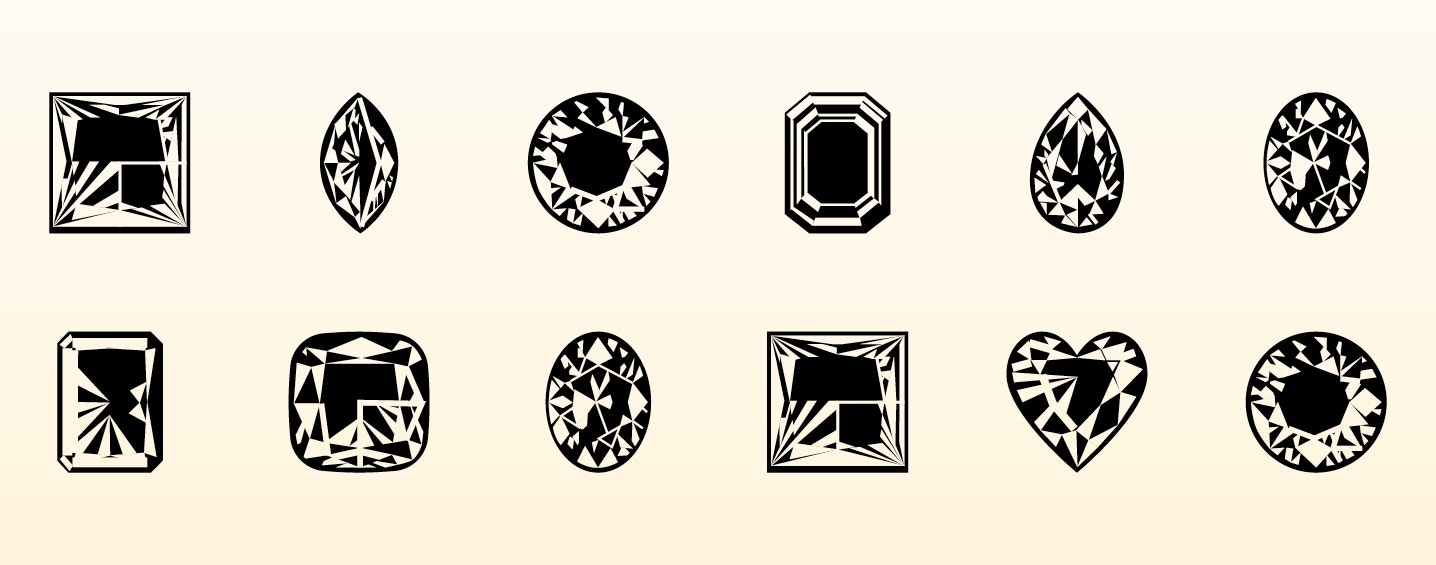The Cost-Effective Choice
Lab-created diamonds offer a more affordable alternative for diamond jewelry while maintaining the same chemical and physical properties as earth-mined diamonds. They have now become the popular choice for many consumers. At Raz and Company, you can find the highest quality, excellently cut lab-created diamonds.
Introduction to Lab-Created Diamonds
Lab-created diamonds are created in laboratories using advanced techniques that replicate the earth-mined conditions of diamond formation in the Earth. These diamonds have the same chemical composition as earth-mined diamonds, consisting primarily of carbon arranged in a crystal structure. They also share identical physical properties with earth-mined diamonds, such as hardness, refractive index, and thermal conductivity. This innovative approach to diamond creation offers consumers a more sustainable and ethical option, combining the allure of traditional diamonds with modern technology and reduced environmental impact.
Distinguishing Lab-created Diamonds from Earth-Mined Diamonds
Lab-created and earth-mined diamonds are visually identical, making it challenging to distinguish between them to the naked eye. While both types of diamonds share the same physical and chemical properties, earth-mined diamonds may contain trace elements not found in lab-created diamonds, which are not detectable by traditional diamond testers.
1. Origin:
Earth-Mined Diamonds: Formed over billions of years under high-pressure and high-temperature conditions deep within the Earth's mantle.
Lab-Created Diamonds: Created in a laboratory using advanced technologies that replicate the earth-mined diamond formation process.
2. Formation Process:
Earth-Mined Diamonds: Develop through earth-mined geological processes involving carbon crystallization under extreme conditions.
Lab-Created Diamonds: Produced using methods such as High Pressure High Temperature (HPHT) or Chemical Vapor Deposition (CVD), which replicate the conditions required for diamond formation.
3. Rarity and Value:
Earth-Mined Diamonds: Considered rare and traditionally valued higher due to their scarcity and the perception of their rarity.
Lab-Created Diamonds: While increasingly accepted, they are less rare and typically valued lower compared to earth-mined diamonds.
To differentiate between lab-created and earth-mined diamonds, specialized detection methods are used. These include examining inclusions, analyzing fluorescence patterns, conducting spectral analysis, and using advanced detection tools designed to identify unique growth features.
The Creation Process of Lab-Created Diamonds
Lab-Created diamonds are created using advanced technologies that replicate the earth-mined conditions under which diamonds form in the Earth. There are two primary methods for producing lab-created diamonds:
1. High Pressure High Temperature (HPHT) Method:
Process: The HPHT method simulates the extreme pressure and temperature conditions found deep within the Earth’s mantle. A small diamond seed is placed in a chamber with carbon, and both are subjected to high pressure and temperature.
Formation: Carbon atoms crystallize around the seed, forming a diamond crystal. This process closely mimics earth-mined diamond formation, resulting in diamonds with properties nearly identical to those found in nature.
2. Chemical Vapor Deposition (CVD) Method:
Process: The CVD method involves placing a diamond seed in a vacuum chamber filled with carbon-rich gasses, such as methane. The gasses are ionized into plasma, and carbon atoms are deposited onto the seed, layer by layer.
Formation: The carbon atoms crystallize on the seed, creating a diamond crystal over time. The CVD process allows for precise control over the diamond’s properties, including its color and clarity.
Lab-created diamonds provide a sustainable and often more cost-effective alternative to earth-mined diamonds, offering the same exceptional beauty and durability. They are an increasingly popular choice for consumers seeking ethical and environmentally friendly options in their jewelry.
Why Choose Lab-Created Diamonds?
Lab-created diamonds offer a range of benefits that make them an appealing choice for many consumers. Here are some key reasons to consider lab-created diamonds:
Cost-Effectiveness: Typically 60-70% less expensive than earth-mined diamonds, allowing for larger or higher-quality stones at a lower price.
Higher Quality: Easily available in higher color and clarity grades compared to earth-mined diamonds, which are rarer and more costly.
Colored Diamonds: Lab-created diamonds can be created in a variety of colors, including hues that are rarely found in nature, providing unique options for personalized jewelry
Innovation and Technology: Produced using advanced techniques like High Pressure High Temperature (HPHT) and Chemical Vapor Deposition (CVD). These advanced methods not only ensure exceptional beauty but also showcase the latest in scientific innovation.
In summary, lab-created diamonds offer a cost-effective, high-quality, and ethically sourced alternative to earth-mined diamonds, making them a smart choice for those seeking both beauty and value.
LAB CREATED DIAMONDS FAQ
- Is There a Visible Difference Between Earth-mined and Lab-Created Diamonds?
No, earth-mined and lab-created diamonds appear identical to the naked eye. Both share the same chemical composition and physical properties. Differentiating them requires specialized laboratory equipment, as their visual and structural attributes are indistinguishable without advanced testing. - Why Are Lab-Created Diamonds Less Expensive?
Lab-created diamonds are more affordable than earth-mined diamonds primarily because of their creation process. Earth-mined diamonds formed over millions of years deep within the Earth's mantle, requiring extensive mining and resource extraction. In contrast, lab-created diamonds are produced in controlled laboratory environments that replicate the earth-mined conditions but in a much shorter time frame. This efficient production process reduces costs associated with mining, transportation, and other factors, making lab-created diamonds a more budget-friendly option. - Do Lab-Created Diamonds Have Inclusions?
Yes, lab-created diamonds can have inclusions, much like earth-mined diamonds. These internal imperfections arise from the methods used to create them. However, lab-created diamonds generally have fewer and less noticeable inclusions thanks to advanced production techniques and rigorous quality control, often resulting in high clarity. At Raz and Company, we provide lab-created diamonds of exceptional color and quality, striving to offer options with minimal to no visible inclusions. - Are Lab-Created Diamonds Real?
Yes, lab-created diamonds are authentic diamonds. They have the same chemical structure, physical characteristics, and brilliance as earth-mined diamonds. The key distinction is their origin: lab-created diamonds are manufactured in controlled environments using advanced technology, whereas earth-mined diamonds are formed over millions of years deep within the Earth's mantle. - Is Cubic Zirconia (CZ) the Same as a Lab-Created Diamond?
No, cubic zirconia (CZ) and lab-created diamonds are not the same. CZ is a synthetic gemstone made from zirconium dioxide, while lab-created diamonds are genuine diamonds created from carbon. Lab-created diamonds have the same physical and chemical properties as earth-mined diamonds, including their hardness and brilliance, whereas CZ is less durable and does not match the brilliance of real diamonds. - Can You Find GIA-Certified Lab-Created Diamonds?
Yes, at Raz and Company, we offer a selection of GIA-graded lab-created diamonds. While many customers opt for IGI for lab-created diamonds due to its physical certification, GIA currently provides only electronic certificates for these diamonds. - How Long do Lab-Created Diamonds Last?
Lab-created diamonds are just as durable and enduring as earth-mined diamonds. Composed of carbon arranged in a crystal lattice, they possess the same hardness and resistance to scratches, chips, and tarnishing. With appropriate care, a lab-created diamond will retain its brilliance and beauty for a lifetime and beyond. - Are Lab-Created Diamonds the Same as Moissanite?
No, lab-created diamonds and moissanite are not the same. Lab-created diamonds are real diamonds created in a laboratory, sharing the same physical, chemical, and optical properties as earth-mined diamonds. Moissanite, on the other hand, is a different gemstone composed of silicon carbide. While moissanite has a similar appearance to diamonds, it has distinct properties such as higher brilliance and a different hardness level.
We're Here to Help
Choosing the right diamond can seem overwhelming, but that’s where our expert team comes in. Simply provide your budget, and we’ll present the best options tailored to your needs. During your appointment, our team will guide you through the differences and key factors to consider. Book your appointment today, and we will make the process seamless for you!




